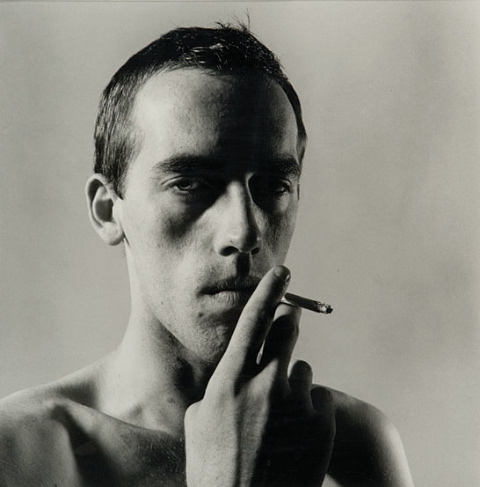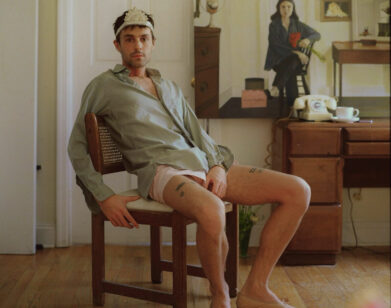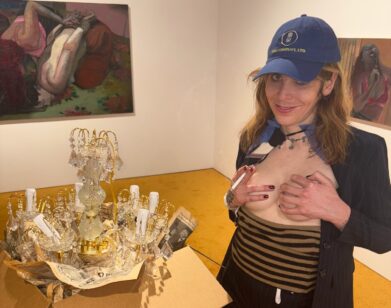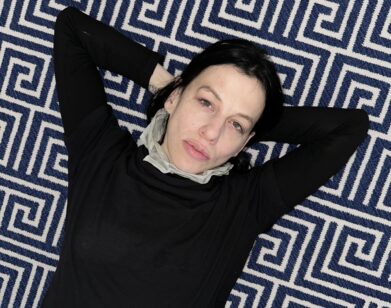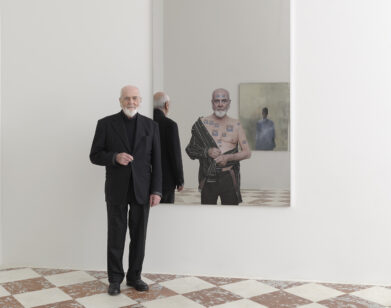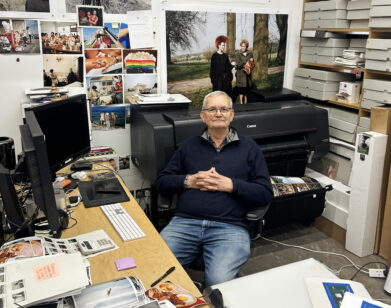Collecting the Male: Interview with Vince Aletti
A new catalogue of the collection of Vince Aletti, Male (Andrew Roth Inc./PPP Editions), includes a pullout centerfold of photographs from the collector’s home. In those images, books and periodicals tower in three-foot stacks about tabletops, and every one is topped with another picture. The resident might be a packrat if it weren’t all so clearly meticulously arranged.
Aletti, the renowned curator, writer, and editor, has collected since the 1970s. Male follows an exhibition of the same name, hosted by New York’s White Columns and Vancouver’s Presentation House, and includes 300 reproductions, a fraction of Aletti’s collection and not including his recent acquisitions. Certain themes emerge: obviously, its 90% photography and even more frequently involves the male body and the homosocial gaze. But the works pictured evince an incredible openness: fine art photography is mixed with ephemera and anonymous works, and Aletti is in subtle ways interested in the female gaze as well (photographer Collier Shore wrote the catalogue essay).
Andrew Roth Gallery celebrates Male on December 18, 6–8 PM. Copies are currently available.
Alex Gartenfeld: Does you apartment always look the way it does in the catalogue?
Vince Aletti: In general, yes, except now it has more piles of books in it.
AG: What is hanging over your bed?
VA: An unstretched, unframed ’40s flea market painting of a man seated in a white bathing suit, a Walter Rosenblum photograph of three men on a stoop in East Harlem, 1952, a small picture of a naked man in a hat by an anonymous Italian photographer, ca 1910, and another unstretched painting by Dale Wittig of individual portraits of four workers from his neighborhood in San Francisco.
AG: Do you have a favorite photographer?
VA: No. I have many.
AG: What photograph would you most like to own?
VA: Richard Avedon’s portrait of Lew Alcindor standing on a basketball court in uniform, 1963. Or practically any one of Irving Penn’s “small trades” series from New York, Paris, and London, early 1950s. Or one of Warhol’s stitched photographs. Or… This is a dangerous question.
AG: Where did you first come to find these works?
VA: The first group of things that I bought, in the late 70s, and which affects everything that I buy now, were these small physique photographs, at a store called Physique Memorabilia, which was 12th Street. It was kind of a secret place in a loft, a block from the Strand. Somebody lived there but they used the front part as a place to sell old physique catalogues and photos. Each week there seemed to be new things, and it was a block from my house. I kept going back, and after it closed, never again ahs there been a place like that.
AG: Do you remember the first thing you bought?
VA: My memory is too bad to even try to pull this up from the past, but it seems to me the first photos I bought at Physique Memorabilia were by Bruce of Los Angeles, whose work was so polished and classic—homoerotic Hollywood glamour. And the prints themselves—commonly 4 X 5 in.—were gorgeous, on nice heavy paper with a matte finish, and more often than not in mint condition. I started going to PM regularly in the early 80s; it was only two block away and browsing there was the perfect rainy-day activity. It was easy to walk out with a handful of amazing little photos when prints didn’t cost more than 50 cents or $1. But the more I looked, the more eccentric my choices became. I started discovering all the other physique studios—AMG, Kris, Cavalier, Lon, Western Photography Guild—and looking for oddities: rodeo shots, weird props, portraits, drawings, the rare non-white subjects. Before the place closed in the mid-1980s, I must have bought several hundred photos, plus magazines, contact sheets, and bits of ephemera—like the drawing pad that some guy had filled with tracings of bodybuilders from muscle magazines, adding the oversized genetalia he imagined they had.
AG: One notable element of the collection is your refusal to differentiate between art and other objects. But did you begin to collect “framed” works at a certain point?
VA: The first photograph in a frame that I bought was a small gallery in the East Village that no longer exists. It was by a guy named Todd Smith who I haven’t been able to track down. It’s a picture of Latino teenagers at Coney Island, holding up two studio portraits they’d just had made–photos within photos are always interesting to me. It was made in 1975 and I probably bought it that same year–first time I spent real money on a photograph, but if I remember correctly it wasn’t more than $75 at an East Village photo gallery whose name now escapes me. I haven’t been able to relocate Smith or find out anything about him.
AG: Are there stores you still like to go to?
VA: I still buy a lot of material at the flea market. I recently found a group of portraits of Chinese men, from probably the 1920s and 1930s. A lot of the stuff I get at flea markets is completely anonymous, and that’s part of the intrigue for me.
AG: What is your favorite piece in your collection right now?
VA: A Kehinde Wiley edition, a bust, a marble bust of a man with drapery. I’m so glad I got it. It’s relatively small and it’s on my mantle right now.
VA: What work from you collection would you call the most provocative from your collection?
AG: A year ago, I found at the flea market a huge group of color polaroids, taken by a man who obviously liked having sex with black men. He photographed them naked in bed with hard-ons and with cum all over their chests. They were actually very beautifully done, but he had very much of a one-track man. They were mostly cropped at the neck, and when I found them they were in a huge cardboard box they were organized by first name in little Ziploc baggies.
AG: Does you think of yourself as affecting the audience for homoerotic imagery?
VA: I’m really glad that so many women respond to the work. For me it’s about thinking about and really working through ideas of masculinity. It’s about what men are and how they act and why.

